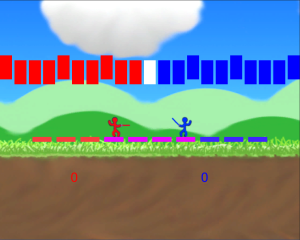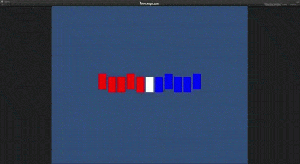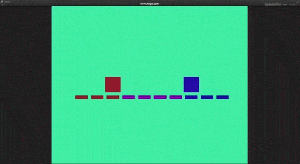Bryan, Sam and I have been working on very small prototype of a rhythm-based fencing game, which is basically a Necrodancer and Nidhogg mashed-up, albeit a quick and dirty one.
A visualization of the rhythm that Sam hooked up to represent when the player can move, and the basic tile movement Bryan rigged up.
The idea is that all the players’ movements can only be executed if they are on the beat. The goal of the game is to score the most number of points. You do this by landing a lunge successfully. The mechanics include moving right and left, lunging, which you do by default when moving forward, parrying, which deflects a lunge, and feinting which fools a parry. In the cases where a player executes a successful parry or feint, the other player cannot attack on the next beat leaving them open to a lunge, but they can retreat. Lunging in turn breaks through a feint and scores a point.
Lunge, Feint, Parry, Open to attack and Off the best
Player movement is tiled, meaning they can move only one tile every beat. Players may not occupy the same tile, so if there is one tile between them and they are both trying to advance onto it, they will stay in the same position. If both players execute the same move on each other, i.e., lunge-lunge, feint-feint, parry-parry, they are each thrown back one tile so there are two tiles between them so they have space to regroup and choose their next move. After each point each player is reset to their original tile to start a new bout. This is faithful to actual fencing, and to give the players the chance to try out different strategies.







